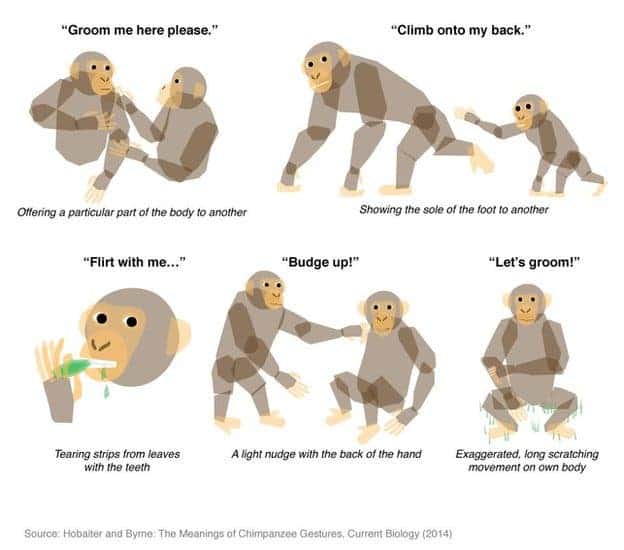If you’ve ever watched chimps during a nature program and became startled by your own empathy towards them, you’re not alone. It’s no secret that chimps are our closest relatives out of all primates, having 98% similar DNA. It goes further than genetics – it’s enough to look a chimp in the eye. The reflection is more than a physical mirror; there’s a connection, and a recent study shows yet again how ‘human’ chimps can be. After closely following chimps for thousands of hours, British researchers finally cracked chimps’ communication code. The result: we now have a dictionary of 66 chimp gestures, often and dynamically used by the primates to intentionally convey meaning to one another. This might just be one of the most important contributions in animal behavior and biology in a long time.
Chimp sign language
The researchers analyzed more than 5,000 meaningful exchanges between chimps, before they could settle on the most defining ones. Some of these gestures are unambiguous – used consistently to convey one meaning. Not surprisingly, some are very subtle. A chimp clipping a leaf, for instance, is eliciting sexual attention from a potential mate. Other gestures are ambiguous and have different meanings depending on the context. When a chimp grabs another chimp, he communicates “Stop that,” “Climb on me,” or “Move away,” depending on the situation.
A while ago, researchers showed that the gelada – a primate that closely resembles the baboon – can howl in a distinct manner mirroring human speech in some respects. Other research showed that monkeys and apes can understand complex information from another brethren’s call, but chimps are the only animals that intentionally communicate through gestures, apart from humans.
“It’s a bit like if you pick up a hot cup of coffee and you scream and blow on your fingers,” Dr Catherine Hobaiter, Professor at University of St. Andrews, who led the research,
“I can understand from that that the coffee was hot, but you didn’t necessarily intend to communicate that to me.”
What makes you human?
So, if you had any doubts until now that there are other beings in this world (no aliens!) that share some of your emotions, and actually communicate these feelings, you have to look no further. Really, we’re not all that different. But this isn’t the end of it. Most likely, chimps use more commonly accepted gesture to communicate, and this need documenting. Also, it would be interesting to see how gestures evolve in a chimp community. After all, chimps seem to have fashion fads too. There’s no telling how truly complex and dynamic chimp society is.
“I have the impression that there were some meanings we couldn’t capture,” Hobaiter said. Sometimes, she recalled, a chimpanzee would gesture to another, then appear satisfied, though nothing else seemed to happen. Said Hobaiter, “I’d love to know what was going on!”
The chimp lexicon was described in a paper published in the journal Current Biology.







